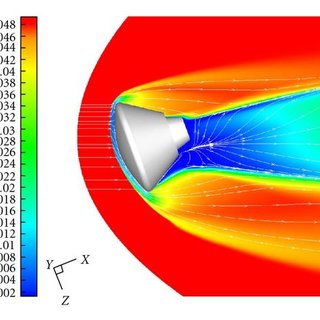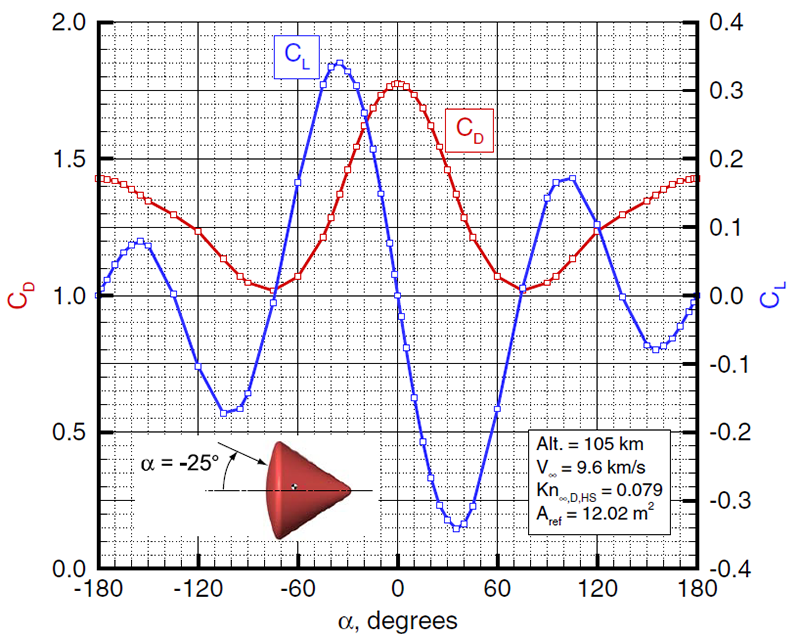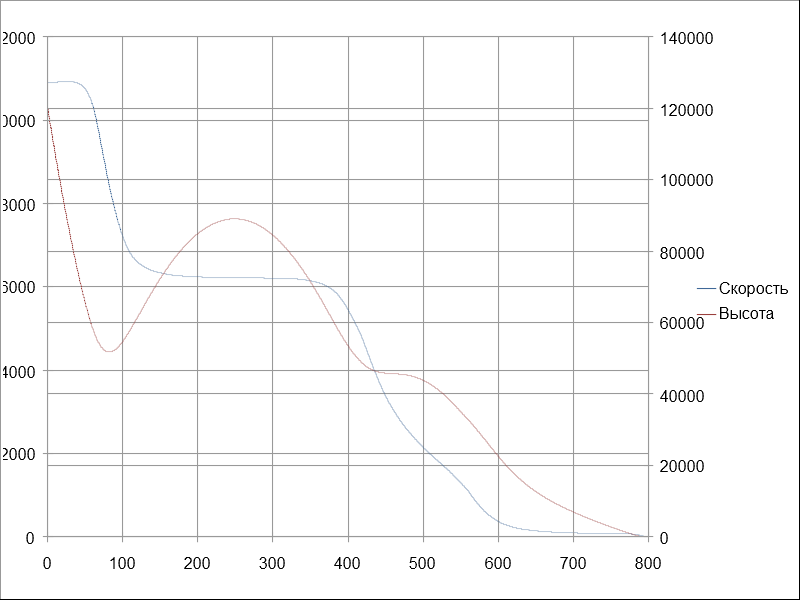In the previous part, the ballistic model showed that it corresponds to Kepler's elliptical theory and adequately estimates the aerodynamic drag. Now let's proceed to a more complex scenario with the entry into the atmosphere of a ship with aerodynamic quality.
Capsule spacecraft with low aerodynamic quality. What is it?
Let us choose the concept of a "capsule" spacecraft, which has been repeatedly tested in practice. Such a spacecraft can be imagined as a blunt cone (such a figure has important features of hypersonic flow)
What is a capsule ship, and why is it interesting
The "thin", well-streamlined hulls, wings and stabilizers of conventional aircraft form attached shock waves that generate heat in the immediate vicinity of the surface of the spacecraft.
And the blunt and rounded lower surface of the Soyuz, Orion capsule creates a powerful detached jump, in which the main part of the released energy goes into the wake, and the smaller part that falls on the spacecraft hull is retained by the ablative thermal shield. The cladding panels are destroyed, and the evolved gases create a protective layer, the coke layer provides thermal insulation, and the reinforcing fibers - glass fiber or carbon yarn - restrain the carryover of pyrolysis products by the oncoming stream.

Calculation of the flow around a "capsule" spacecraft. The color shows the level of dissociation of the flow, which is especially intense in the bow shock and wake behind the ship. It can be seen that the shock wave does not touch the surface of the ship.
By shifting the center of mass, a gas-jet attitude control system or aerodynamic rudders, it is possible to keep the blunt side of the capsule at an angle to the flow, creating a lift. Firstly, it is possible to keep the trajectory from rapidly descending into denser layers of the atmosphere (and to limit both overloads and heat fluxes), and secondly, by creating a roll, turn the lift vector and maneuver along the course angle.
Apollo. Trajectory characteristics and initial conditions
For the trajectory calculation, we will choose the Apollo spacecraft. The key aerodynamic characteristics are the coefficients of lift (Cya) and drag (Cxa). The available figures are contradictory, but if we try to average the sources, we get that Cxa ~ 1.1 - 1.8, ya ~ 0.25 - 0.35. We will take data from the article "DSMC Simulations of Apollo Capsule Aerodynamics for Hypersonic Rarefied Conditions" (9th AIAA ASM Thermophysics and Heat Transfer Conference 5-8 June 2006 San Francisco CA). Since the aerodynamic coefficients change little at hypersonic speeds, and tend to constant values with an increase in the number M, we will extend these data to the entire speed range.
Characteristics from the article

For compatibility with other ADH tables, we will assume alpha = -alpha
. H = 120 , Th = -6.93 , V = 10.9 / - S = 11.94 2, m = 5460 , 300 (, 2750 / "- ")
, ( - )
t, |
H, |
L, |
V, / |
aX, /2 |
Q, |
78 |
46,06 |
793,8 |
7217,2 |
-222,7 |
57227 |
78,5 |
45,81 |
797,4 |
7106,1 |
-223,1 |
57330 |
79 |
45,57 |
800,9 |
6994,8 |
-223,1 |
57320 |
45 22g, . 57,3 - . "" .
, ( - 40 45 )
( )
t, |
V, / |
H, |
L, |
aX, /2 |
aY, /2 |
Q, |
72,5 |
9307,9 |
52,89 |
761,4 |
-95,1 |
23,3 |
35507 |
73 |
9260,5 |
52,77 |
766 |
-95,1 |
23,3 |
35510 |
73,5 |
9213,1 |
52,66 |
770,6 |
-95,1 |
23,3 |
35484 |
, 2 (9.9g). 35,5 . 90 . , ( 52,7 ). :
( )
t, |
V, / |
H, |
L, |
aX, /2 |
aY, /2 |
Q, |
426,5 |
4405,3 |
47,38 |
2962 |
-48,89 |
12,94 |
17505 |
427 |
4381 |
47,31 |
2964 |
-48,89 |
12,94 |
17504 |
3312 .
. NASA
(, ). 4- Apollo (ENTRY AERODYNAMICS AT LUNAR RETURN CONDITIONS OBTAINED FROM THE FLIGHT OF APOLLO 4 (AS-501) NASA TN D-5399)
|
satMod.js |
NASA (.24) |
|
73 |
77 |
|
427 |
463 |
6 |
512 |
537 |
3 |
567 |
585 |
1.1 |
603 |
634 |
, NASA Cxa ~ 1,35 - 1,4. Cxa - 1,78
-

- , - , -
.

.

- , /, - , . OX -
, . , . , .
. SpaceX Dragon
v1 - , v0 - , a - , H - . m - , J -
t, |
H, |
V, / |
aX, /2 |
dM, / |
M, |
784,4 |
360 |
66 |
-10,03 |
0 |
5460 |
784,9 |
328 |
62,5 |
-21,1 |
-23,62 |
5453 |
790,4 |
98 |
27,1 |
-13,72 |
-23,06 |
5325 |
793,4 |
33 |
17,3 |
-12,66 |
-22,77 |
5256 |
795,4 |
3 |
12 |
-12,28 |
-22,57 |
5211 |
12 / ( - 10 /), 249 300 .
0.1 1.75 / 25 , - 120 . ~ 400 , ( 83 1 , Apollo 400-470 .
, .
Descent with lift actually reduces the acting overloads and the aerodynamic (hence, thermal) effect on the spacecraft, and also expands the landing zone. We also managed to consider a soft landing of the spacecraft using a braking propulsion system.
The next step is to study a spacecraft with a high aerodynamic quality (load-bearing body and winged spacecraft), as well as supplement the model with an estimate of the lateral maneuver.